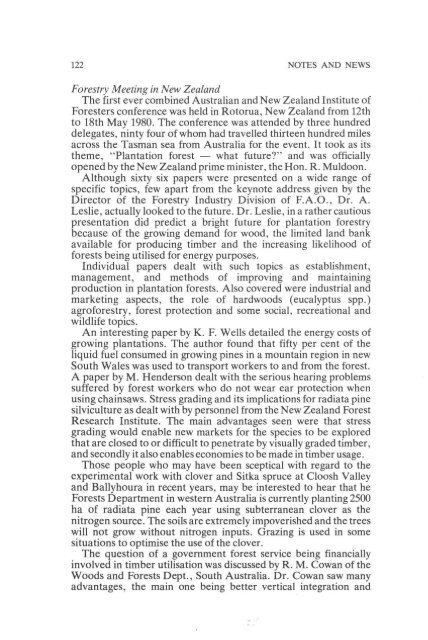Download Full PDF - 28.68 MB - The Society of Irish Foresters
Download Full PDF - 28.68 MB - The Society of Irish Foresters
Download Full PDF - 28.68 MB - The Society of Irish Foresters
Create successful ePaper yourself
Turn your PDF publications into a flip-book with our unique Google optimized e-Paper software.
122 NOTES AND NEWS<br />
Forestry Meeting in New Zealand<br />
<strong>The</strong> first ever combined Australian and New Zealand Institute <strong>of</strong><br />
<strong>Foresters</strong> conference was held in Rotorua, New Zealand from 12th<br />
to 18th May 1980. <strong>The</strong> conference was attended by three hundred<br />
delegates, ninty four <strong>of</strong> whom had travelled thirteen hundred miles<br />
across the Tasman sea from Australia for the event. It took as its<br />
theme, "Plantation forest - what future" and was <strong>of</strong>ficially<br />
opened by the New Zealand prime minister, the Hon. R. Muldoon.<br />
Although sixty six papers were presented on a wide range <strong>of</strong><br />
specific topics, few apart from the keynote address given by the<br />
Director <strong>of</strong> the Forestry Industry Division <strong>of</strong> EA.O ., Dr. A.<br />
Leslie, actually looked to the future. Dr. Leslie, in a rather cautious<br />
presentation did predict a bright future for plantation forestry<br />
because <strong>of</strong> the growing demand for wood, the limited land bank<br />
available for producing timber and the increasing likelihood <strong>of</strong><br />
forests being utilised for energy purposes.<br />
Individual papers dealt with such topics as establishment,<br />
management, and methods <strong>of</strong> improving and maintaining<br />
production in plantation forests. Also covered were industrial and<br />
marketing aspects, the role <strong>of</strong> hardwoods (eucalyptus spp.)<br />
agr<strong>of</strong>orestry, forest protection and some social, recreational and<br />
wildlife topics.<br />
An interesting paper by K. E Wells detailed the energy costs <strong>of</strong><br />
growing plantations. <strong>The</strong> author found that fifty per cent <strong>of</strong> the<br />
liquid fuel consumed in growing pines in a mountain region in new<br />
South Wales was used to transport workers to and from the forest.<br />
A paper by M. Henderson dealt with the serious hearing problems<br />
suffered by forest workers who do not wear ear protection when<br />
using chainsaws. Stress grading and its implications for radiata pine<br />
silviculture as dealt with by personnel from the New Zealand Forest<br />
Research Institute. <strong>The</strong> main advantages seen were that stress<br />
grading would enable new markets for the species to be explored<br />
that are closed to or difficult to penetrate by visually graded timber,<br />
and secondly it also enables economies to be made in timber usage.<br />
Those people who may have been sceptical with regard to the<br />
experimental work with clover and Sitka spruce at Cloosh Valley<br />
and Ballyhoura in recent years, may be interested to hear that he<br />
Forests Department in western Australia is currently planting 2500<br />
ha <strong>of</strong> radiata pine each year using subterranean clover as the<br />
nitrogen source. <strong>The</strong> soils are extremely impoverished and the trees<br />
will not grow without nitrogen inputs. Grazing is used in some<br />
situations to optimise the use <strong>of</strong> the clover.<br />
<strong>The</strong> question <strong>of</strong> a government forest service being financially<br />
involved in timber utilisation was discussed by R. M. Cowan <strong>of</strong> the<br />
Woods and Forests Dept., South Australia. Dr. Cowan saw many<br />
advantages, the main one being better vertical integration and

















